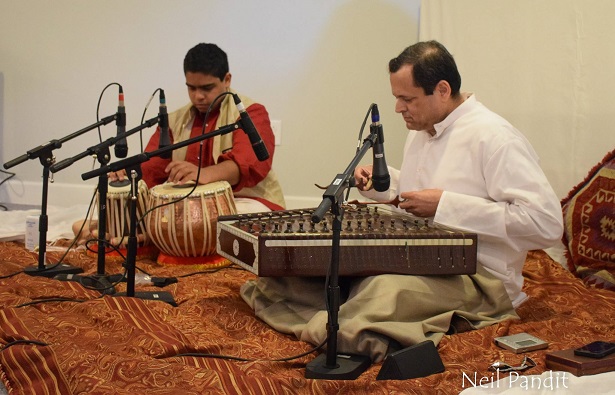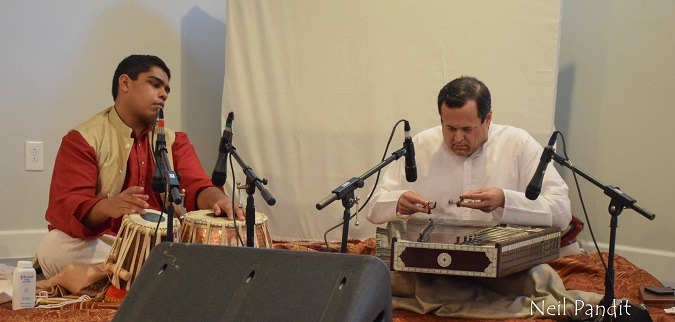Contribute
| Scintillating Santoor And A Vibrant Vocal Performance Delighted KHMC Audience |
Sunanda Narayanan and Sunanda Sahay
06/01/2017
Listening to Shriya Srinivasan’s recital for KHMC made me wonder if indeed some people have more hours in the day, for she is pursuing graduate studies at MIT while simultaneously learning and performing Carnatic music and Bharatanatyam at a highly advanced level! The dedication and talent it takes to excel in one of these disciplines not to mention all of them is truly astounding. Shriya’s approach to music is strictly traditional and her concert for KHMC belied her sound training with Guru Madurai Sundar of Detroit, MI. She commenced with the well-known varnam, Sarasuda, in Saveri ragam, singing it with evident relish for the heavy gamakas (oscillations) that are unique to this ragam. Bhaja Manasa Vigneshwara in Bahudari and Guruleka Etuvanti in Gowri Manohari paid obeisance to the elephant-faced Remover of obstacles, and to the guiding Guru who illumines the mind. The kalpanaswarams for Gurulekha revealed good creativity in patterns and tight control over talam. Ragam Shubhapantuvarali was a good choice for a morning chamber concert with an intimate audience. The Alapanai flowed with soulfulness and a deep feeling for the contours of the ragam. Giridhari Venkatadri on the violin was excellent in his response and his alapanai revealed a very different and beautiful interpretation of the ragam with languorous phrasing. He is a graduate student at Northeastern University and a senior student of Guru Vidushi Kanyakumari from India. The kriti that followed - Sri Satyanarayanam always tugs at the heartstrings with its emotive appeal, and it was certainly so that morning as well. Peppy Manavyala in Nalinakanti was followed by a heavy Ragam Tanam Pallavi in Kambodhi ragam. The delineation was true to the grammar of the piece with exhaustive handling of each of the aspects and the climax with challenging Koraippu (rhythmic reduction) in the kalpanaswarams and a nice porutham (leading link) back into the “Parimala Rangapathe†Pallavi refrain was catchy. Shri Pravin Sitaram provided a lovely and brief tani avartanam at this point. His accompaniment style is always unobtrusive while being wonderfully supportive, and with a keen appreciation for each sangati in the song. Shriya concluded her recital with three sweet compositions - Kamalanayana Vasudeva in Ragam Chenchurutti, Javali Nirupamaana Sami in Ragam Behag, and Thamizh Arutpa Karaaya Vanna in Ragam Sindhubhairavi, each like a petite dessert at the end of a satisfying meal! She shows great promise and maturity and certainly has a bright future ahead of her. When we received the invitation from KHMC to attend the recital of Santoor by Sri Nitin Pandit ji, accompanied by our own Pranav Ghatraju on tabla, we knew we had to find a way to attend it, even though, in our extremely talented and active New England art community, it's hard to find time on a weekend that is not already committed. In any case, we found ourselves driving to the home of Mrs. Amrutha and Mr. Pandu Varada who hosted the KHMC event on Sunday, May 20th. Please click here for a sample of the concert - https://www.youtube.com/watch?v=gHn970T1qf4 https://www.facebook.com/groups/445214352267755/?hc_ref=SEARCH
We just arrived in time to listen to the last part of the vocal performance by the young and talented Shriya Srinivasan. She was accompanied by Giridhari Venkatadri on violin and Pravin Sitaram on Mridangam. It is good when upcoming artists get their own ‘youth platform’. It not only encourages them to polish their art, but also heightens the aura of artistic sensitivity that increases the joy of listening to the senior artists who follow them.
The afternoon performance began with Santoor recital by Shri Nitin Pandit. Nitin ji, who is a disciple of famous maestro Pt. Shiv Kumar Sharma, is the only santoor player in the entire New England region. Nitin ji was not born in a family of musicians. When he was a teenager, he listened to a santoor recording and was smitten by its sound. He self-taught himself for years, and eventually was accepted as a disciple by Pt. Shiv Kumar Sharma. Nitin ji’s playing style has the same evocative sound that tugs at your heart, and his ragas easily transported us to the valleys of Kashmir, the home of Santoor.
Pranav Ghatraju also did a fine job of keeping up with the varying styles and Thekas in true jugalbandi style. The duo captivated us through the Alaaps and taans of rag Charukeshi followed by Raag Rageshri in vilambit and drut laya. The performance closed with two beautiful thumris in misra raga that easily brought to mind the charming redolent hills of Kashmir. As he switched from one raga to another, Santoor needed re-tuning each time so that the strings on the right side represented the notes specific to that raga. Nitin ji also described that the ancient Sanskrit texts refer to a similar 100-string lute called the Shata Tantri Veena. It had 25 courses, each with four strings. His guru, in order to expand the tonal range, modified the instrument so that it now consists of 31 courses, each with three strings. The Santoor also resembles the Santur of Iran (their national instrument) and the American dulcimer. However, the mallet (mezrab) in the hands of an Indian artist moves much more delicately than the hammer in the hands of a dulcimer player.
A big thanks to KHMC for organizing such wonderful event which was made all the more enjoyable with the potluck lunch. Lovely weather complemented a perfect evening. Jeyanthi Ghatraju conducted the entire program and profusely thanked the accomplished artists and the hosts for a memorable musical day.
You may also access this article through our web-site http://www.lokvani.com/

